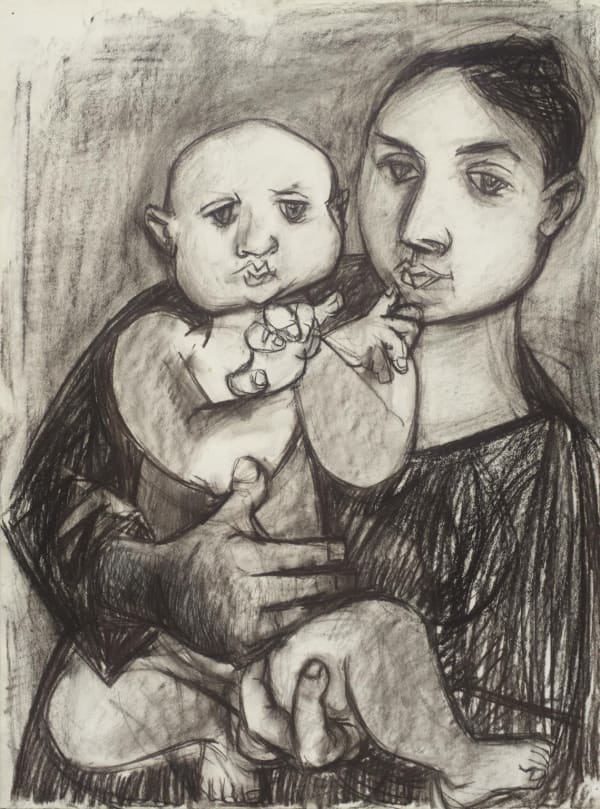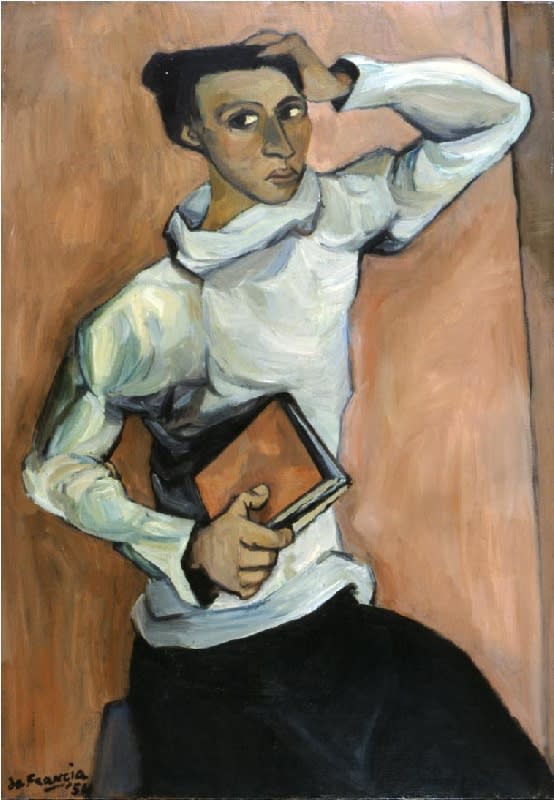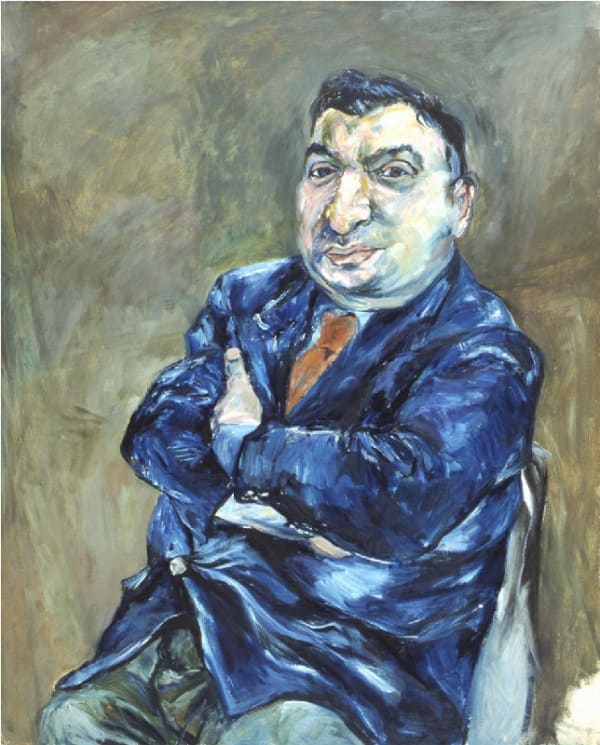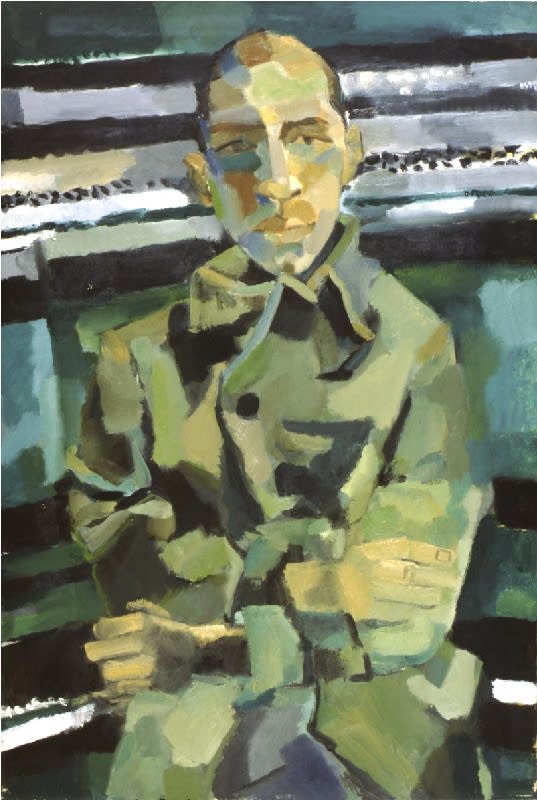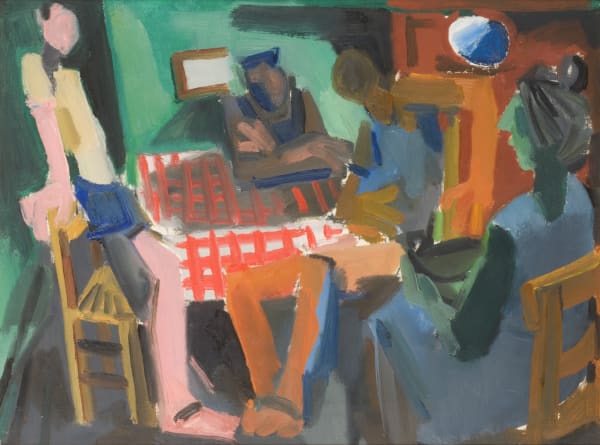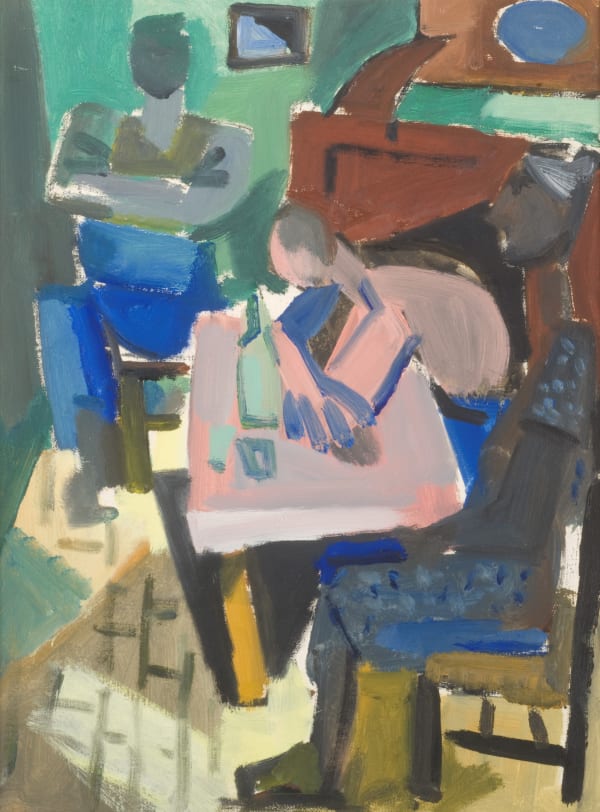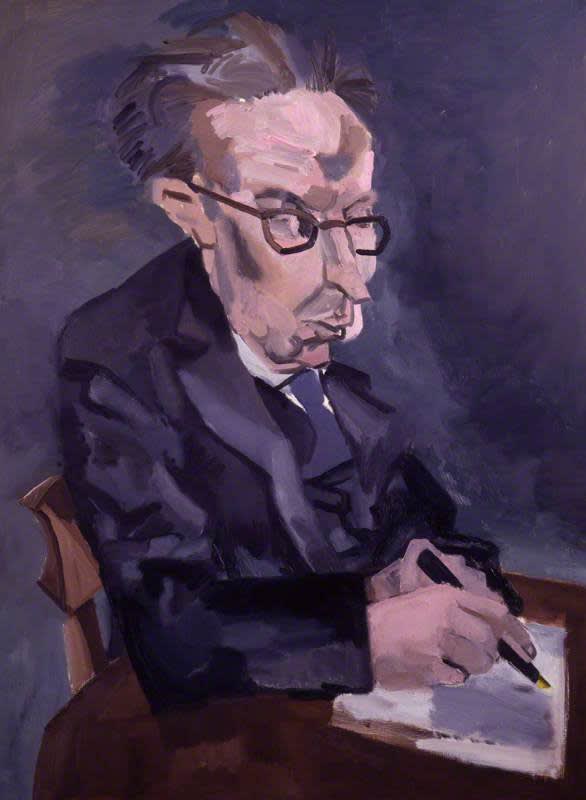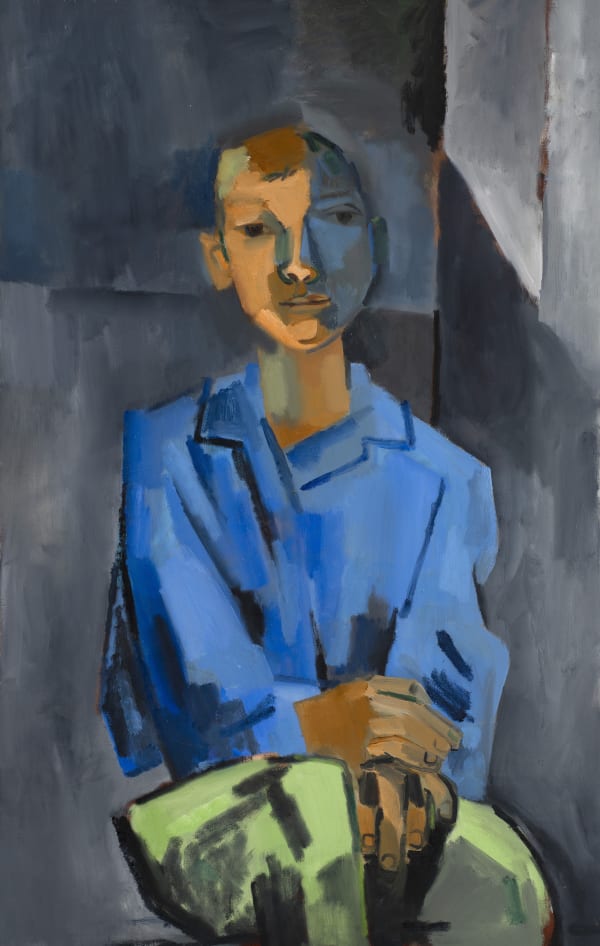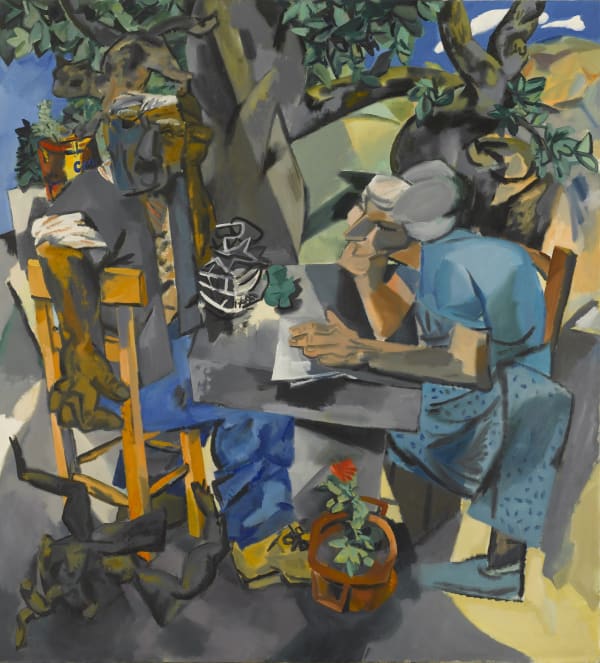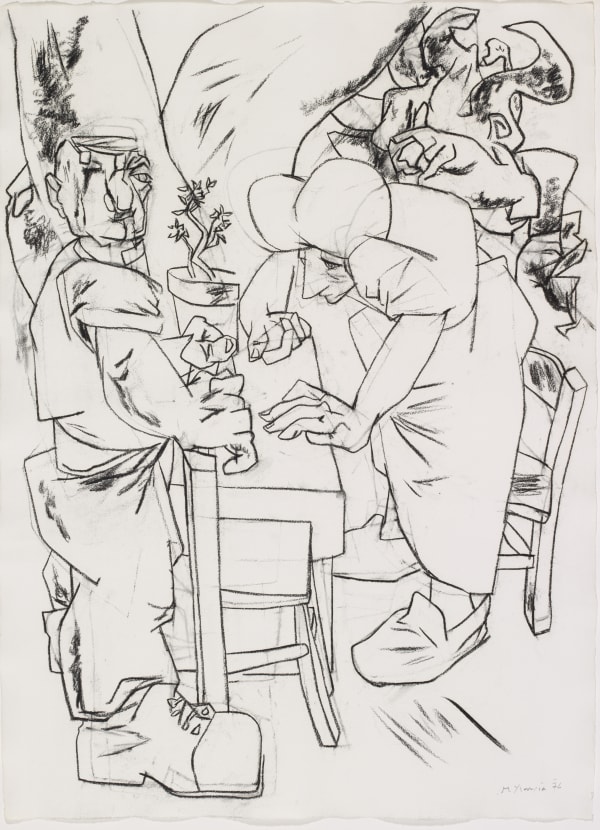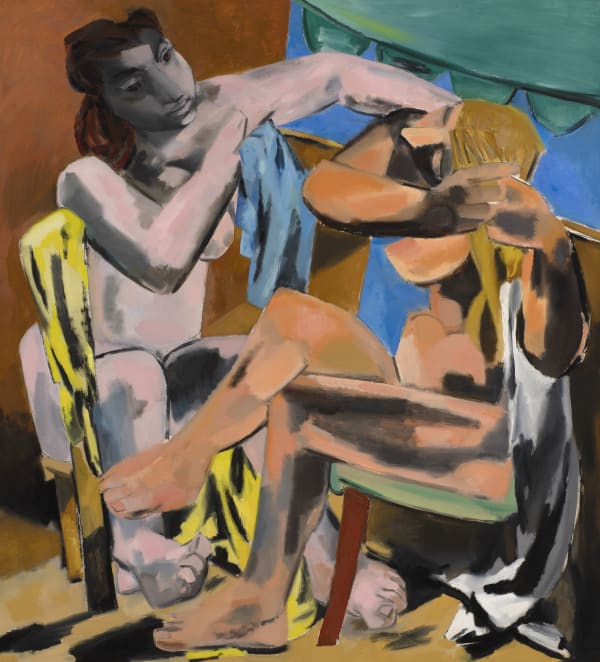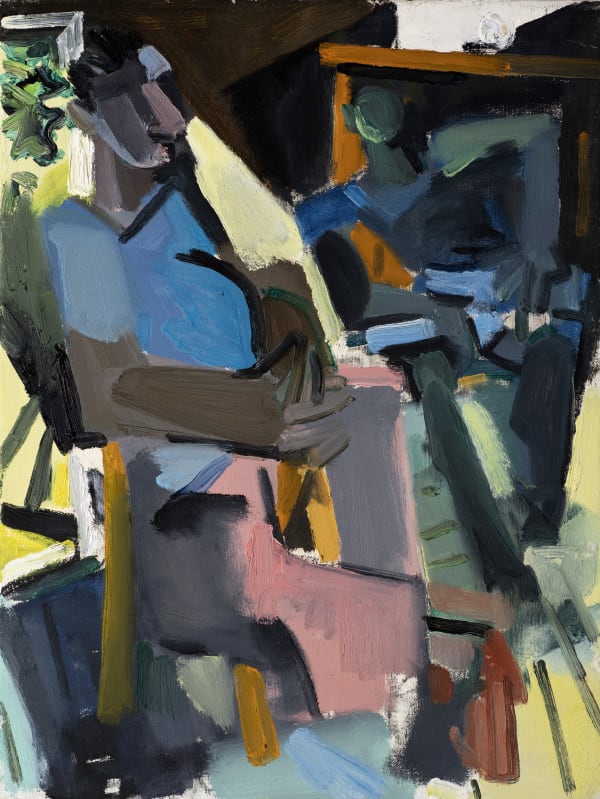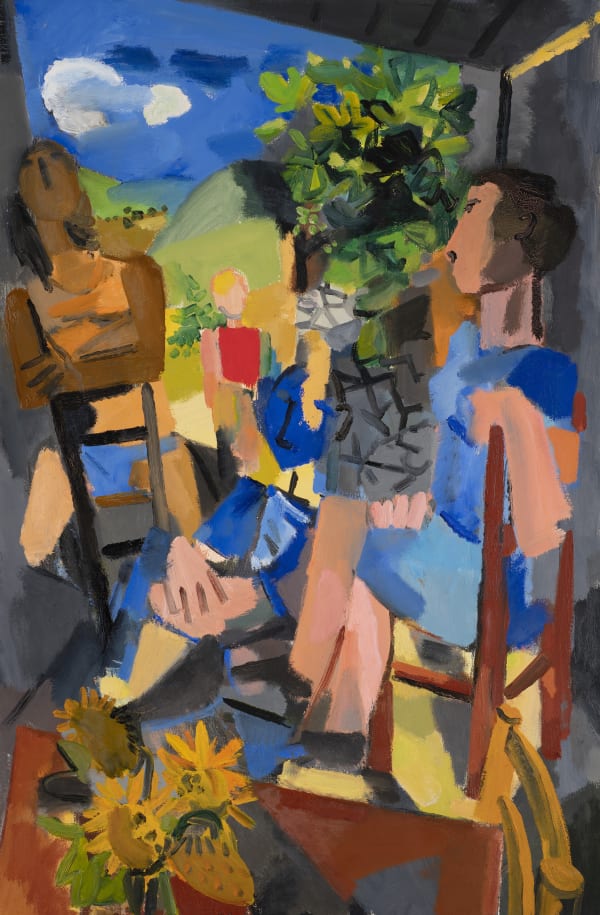Portraiture was a mode in which de Francia could give free rein to an innate desire to get across the humanness of his sitters. His subjects include leading lights of the British left – the historian Eric Hobsbawm; the scientist JD Bernal; the composer Alexander Goehr – and of international figures such as the Italian poet Salvatore Quasimodo. But it is typical of de Francia that the emotional intensity of these portraits is equalled by his portraits of otherwise unknown figures – such as the farmers Monsieur and Madame Beylac, who owned a small farm in southern France and whom de Francia called ‘the last vestiges of a totally vanished society’. Much like those of his near contemporary Alice Neel, de Francia’s portraits are distinguished by psychological acumen, social engagement and expressive mastery of line and colour. These qualities are also at play in his anonymous figure compositions – of women washing their feet; boys sipping cups of tea; couples riding bikes and Vespas; families lighting lamps for the evening, or simply lounging around. A world away from the combative, large-scale depictions of modern history for which he is best known, de Francia’s more intimate and withdrawn figure paintings are none the less political. Like Shakespeare’s Hamlet, de Francia understood that ‘the interim is mine’, finding something approaching the truth of life in moments of quiet, unassuming activity.
-
-
 Woman Washing, 1950sOil on canvas91.5 x 71cm
Woman Washing, 1950sOil on canvas91.5 x 71cm -
 Seated Boy, Genoa, 1950sCharcoal on paper45.1 x 35.1cm
Seated Boy, Genoa, 1950sCharcoal on paper45.1 x 35.1cm
Tate -
 Mother and Child, c. 1953Charcoal and conté on paper77.2 x 57.3cm
Mother and Child, c. 1953Charcoal and conté on paper77.2 x 57.3cm
Tate
-
 Anna Bostock I, 1954Oil on canvas115.5 x 80cm
Anna Bostock I, 1954Oil on canvas115.5 x 80cm -
 Anna Bostock II, 1950s?Oil on canvas112 x 76.5cm
Anna Bostock II, 1950s?Oil on canvas112 x 76.5cm -
 Chinese Acrobats, 1956Pen and ink35.5cm x 25.5cm
Chinese Acrobats, 1956Pen and ink35.5cm x 25.5cm
Morley College, London
-
 Chinese Acrobats, 1956Pen and ink35.5cm x 25.5cm
Chinese Acrobats, 1956Pen and ink35.5cm x 25.5cm
Morley College, London -
 Old Man and a Boy, 1956Oil on canvas152.4 x 91.6cm
Old Man and a Boy, 1956Oil on canvas152.4 x 91.6cm
Sheffield Museums -
 Quasimodo and his Wife, 1957Oil on canvas121.5 x 76.5cm
Quasimodo and his Wife, 1957Oil on canvas121.5 x 76.5cm
-
 An Indian Student (Kulwant Aurora) 1, 1957Oil on canvas151.5 x 90.5cm
An Indian Student (Kulwant Aurora) 1, 1957Oil on canvas151.5 x 90.5cm -
 An Indian Student (Kulwant Aurora) 2, 1957Oil on canvas152 x 91.5cm
An Indian Student (Kulwant Aurora) 2, 1957Oil on canvas152 x 91.5cm -
 Portrait of an African Girl, 1957Oil on canvas187 x 131cm
Portrait of an African Girl, 1957Oil on canvas187 x 131cm
Sheffield Museums
-
 Sonny Terry/Jazz Musician, 1958Pencil on paper35.4 x 25.3cm
Sonny Terry/Jazz Musician, 1958Pencil on paper35.4 x 25.3cm
Arts Council Collection -
 John Holness, 1959Oil on canvas151.5 x 90.5cm
John Holness, 1959Oil on canvas151.5 x 90.5cm -
 Mordecai Richler, c. late 1950sOil on canvas122 x 106cm
Mordecai Richler, c. late 1950sOil on canvas122 x 106cm
-
 Claudia Roden, c. late 1950sOil on canvas102 x 83cm
Claudia Roden, c. late 1950sOil on canvas102 x 83cm -
 Hugo Manning, c. late 1950sOil on canvas127 x 102cm
Hugo Manning, c. late 1950sOil on canvas127 x 102cm -
 Alexander Goehr, 1960s?Oil on canvas137.5 x 91.5cm
Alexander Goehr, 1960s?Oil on canvas137.5 x 91.5cm
-
 Panama Resting, c. late 1950sOil on canvas115 x 80cm
Panama Resting, c. late 1950sOil on canvas115 x 80cm -
 Eric Hobsbawm , 1950sOil on canvas91.6 x 152.7cm
Eric Hobsbawm , 1950sOil on canvas91.6 x 152.7cm -
 A Cup of Tea, 1959Oil on canvas67.3 x 80cm
A Cup of Tea, 1959Oil on canvas67.3 x 80cm
Herbert Art Gallery, Coventry
-
 Hadara, 1962Oil on canvas151.5 x 91cm
Hadara, 1962Oil on canvas151.5 x 91cm -
 Woman Washing Her Feet, early 1960sOil on canvas92 x 65cm
Woman Washing Her Feet, early 1960sOil on canvas92 x 65cm -
 Woman Washing Hair, 1960s?Oil on canvas40.5 x 30.5cm
Woman Washing Hair, 1960s?Oil on canvas40.5 x 30.5cm
-
 Two Women, 1960sOil on canvas167.5 x 91cm
Two Women, 1960sOil on canvas167.5 x 91cm -
 Figures 1965 (Adrian Family), 1965Oil on board29 x 39cm
Figures 1965 (Adrian Family), 1965Oil on board29 x 39cm
Alfred East Art Gallery, Kettering -
 Figures 1965 (Adrian Family), 1965Oil on board39 x 29.5cm
Figures 1965 (Adrian Family), 1965Oil on board39 x 29.5cm
Alfred East Art Gallery, Kettering
-
 John Desmond Bernal, 1966Oil on canvas121.9 x 91.4cm
John Desmond Bernal, 1966Oil on canvas121.9 x 91.4cm
National Portrait Gallery, London -
 Couple, 1968Pencil on paper27.3 x 37.4cm
Couple, 1968Pencil on paper27.3 x 37.4cm
Arts Council Collection -
 Portrait of a Boy, early 1970s?Oil on canvas100 x 81cm
Portrait of a Boy, early 1970s?Oil on canvas100 x 81cm
-
 Portrait of a Boy, early 1970s?Oil on canvas130 x 81cm
Portrait of a Boy, early 1970s?Oil on canvas130 x 81cm -
 Portrait of a Woman, early 1970s?Oil on canvas130 x 89cm
Portrait of a Woman, early 1970s?Oil on canvas130 x 89cm -
 Lighting Lamps, 1970Oil on canvas66 x 50cm
Lighting Lamps, 1970Oil on canvas66 x 50cm
-
 Two Nudes, 1973Oil on canvas178 x 152cm
Two Nudes, 1973Oil on canvas178 x 152cm
Pallant House Gallery, Chichester -
 Monsieur et Madame Beylac, 1974Oil on canvas167 x 152cm
Monsieur et Madame Beylac, 1974Oil on canvas167 x 152cm
Arts Council Collection -
 Monsieur et Madame Beylac, 1976Charcoal on paper78.7 x 55.9cm
Monsieur et Madame Beylac, 1976Charcoal on paper78.7 x 55.9cm
Arts Council Collection
-
 Reclining Figures, 1974Oil on canvas106 x 168cm
Reclining Figures, 1974Oil on canvas106 x 168cm -
 Reclining Nude with Radio, 1970sOil on canvas91.5 x 167cm
Reclining Nude with Radio, 1970sOil on canvas91.5 x 167cm -
 Red and Yellow Vespas, 1976Oil on canvas30.5 x 41cm
Red and Yellow Vespas, 1976Oil on canvas30.5 x 41cm
-
 Two Figures and a Vespa, 1976Oil on canvas51 x 66cm
Two Figures and a Vespa, 1976Oil on canvas51 x 66cm -
 Women Washing, 1976Oil on canvas152 x 137cm
Women Washing, 1976Oil on canvas152 x 137cm -
 Domestic Interior, 1978Oil on canvas152 x 132cm
Domestic Interior, 1978Oil on canvas152 x 132cm
Royal College of Art, London
-
 Women and Boy with Pink Ball, 1970sOil on canvas137 x 106.5cm
Women and Boy with Pink Ball, 1970sOil on canvas137 x 106.5cm -
 Couple, Blue Bicycle (White T-Shirt), 1970sOil on canvas41 x 30.5cm
Couple, Blue Bicycle (White T-Shirt), 1970sOil on canvas41 x 30.5cm -
 Courting Couple on Bicycles, 1970sOil on canvas175 x 191cm
Courting Couple on Bicycles, 1970sOil on canvas175 x 191cm
-


